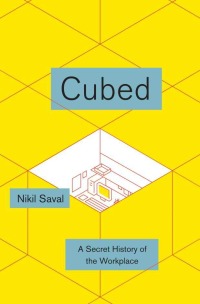Cubed by Nikil Saval
 Friday, May 9, 2014 at 9:59AM
Friday, May 9, 2014 at 9:59AM 
Published by Doubleday on April 22, 2014
I did not know that more than half of working Americans work in a cubicle (or even that more than half work in offices) but since they tend to be hidden from the public, I suppose I'm just not aware of their pervasive existence. I have no trouble believing that 93 percent of those workers dislike their cubes. The cube world has been lampooned in Office Space, The Office, and Dilbert, among other sources of comedic fiction, but Cubed takes a more serious approach to understanding the world of cubes and the workers who inhabit them. Nikil Saval's wide-ranging discussion is largely a history office workers and their changing environment. Saval explains that he wants to tell that story from the perspective of office workers, but that's the book's least successful ambition.
Cubed discusses the history of clerical workers from nineteenth century counting-houses to their role in modern American life. Some early clerks (like Alexander Hamilton and Ben Franklin) rose above their stations while most (as is true today) toiled in obscurity. In the nineteenth century, clerks in literature received little respect (Bartleby and Uriah Heep are notorious examples) while clerks in the real world were mocked for their aristocratic pretensions by the likes of Edgar Allen Poe and Walt Whitman. But growing membership in "the clerking class" arguably gave birth America's middle class. At that point they were mocked (by Emerson, among others) not for pretension but for whininess, a convention that continues in modern satire.
The urbanization of America gave birth to the large office buildings that form the environment Cubed explores. Clerks were lined up in rows to mimic the factory floor until an anal-retentive mechanical engineer named "Speedy" Taylor made efficiency in the factory and in the office a managerial obsession. Cubed gives detailed attention to Taylor, to Frank Lloyd Wright's contribution to modern office design, to skyscrapers, to the growing role of women as clerical workers after the Civil War (with the concomitant fear that they would seduce their unwary bosses in order to secure raises and special workplace privileges), to the impact of labor unions on office work, and to the evolving way in which political movements and political theorists viewed office workers. He also covers the psychology (and pop-psychology) of office workers, the competition between humans and machines, the language of white collar business (complete with sports metaphors), competing styles of office management (from rigid hierarchies to Zen-like naturalism), potted plants as status symbols, and office sex, little of which takes places inside cubicles.
Cubed also offers an introductory course in the theory of office design, illustrated with pictures of office buildings and their interiors. Work spaces themselves become the focus of the last third of the book, including the "action office" (i.e., an easily disassembled cube). As one critic noted, it is a design that works well for office zombies, the working dead who are crammed into small, disposable spaces. Perhaps deliberately, the spaces create no sense of permanence. Still, the Action Office caught fire and spread across America, with managers taking little notice that nearly all the workers hated their cubes, particularly after they started getting smaller ... and smaller ... and smaller. Attempts to reinvent cubes have largely been futile (unless you count Nerf basketball as a serious workplace improvement). Most experiments to replace cubes have failed although Saval suggests that some (like Google's environment) show promise. He also notes that more employers are recognizing that many skilled employees work better at home, a concept that frustrates the controlling desires of middle managers.
Cubed is well-researched and informative but I'm not sure it is anything more than that. The book told me more than everything I always wanted to know about skyscrapers and the history of office workers, but I'm not sure it gave me much insight into how the world is perceived from the confines of a cube, which is Saval's declared intent. I do like the book's pithy characterization description of "the unholy expectations of the modern workplace, which asked for dedication and commitment, offering none in return." And of course I like all the quotations from Office Space and Sinclair Lewis. Cubed is informative and enjoyable, even if it is a bit scattered and doesn't quite meet its stated goal.
RECOMMENDED
Reader Comments